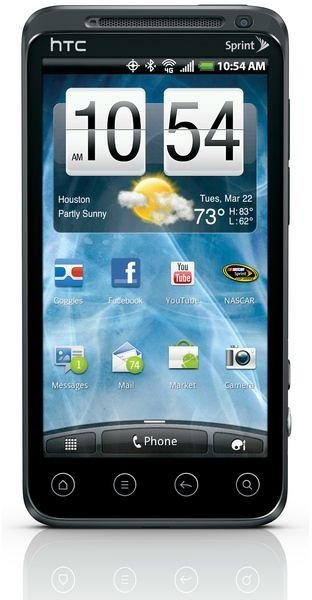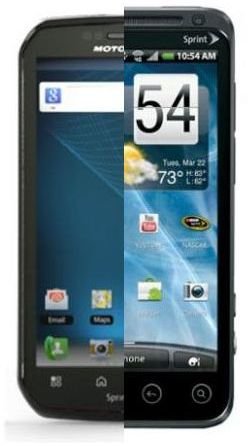Motorola Photon 4G vs. HTC EVO 3D - Which One Sprints to the Finish?
Sprinting for Dominance
The Motorola Photon 4G and HTC EVO 3D are similar, yet very different Android powered smartphones, vying for the same customers on the Sprint network. While the Photon is taking a more classic approach, offering powerful specs in a nicely designed package, the HTC EVO 3D hopes to take smartphones to another dimenson with 3D. Both of these devices are being offered on Sprint, and both are really sprinting to win over customers. When the two are compared, which smartphone is the better smartphone to grab for new and existing Sprint customers?
Design and Display
Both smartphones are very well designed, and both take on the candy bar approach, with their displays dominating the front. The Photon 4G offers qHD resolution and the EVO 3D doesn’t back down as it also offers qHD resolution, but with the ability to display 3D on top of that. Both have beautiful and large 4.3 inch displays, neither backing down when it comes to size and quality, though the EVO 3D edges out every so slightly with its S-LCD display.
They do take slightly different design cues, with the Photon 4G going with a more rugged look with its jagged edges, while the EVO 3D stays with the conservative look found on most other HTC Android devices. Some may prefer the more masculine look of the Photon 4G while others will prefer the more recognizable and traditional square with rounded edges design that the EVO 3D offers. While the EVO 3D does offer the ability to display in 3D, it really isn’t that useful as it has to be placed at an exact angle and really doesn’t help it stand out against the Photon 4G. The Photon 4G does offer a slight addition that the EVO 3D oddly does not have – the kickstand. Most HTC Android powered devices have a kickstand but for some reason they opted not to include it with the EVO 3D. The kickstand is a minor addition to the Photon 4G but it makes it stand out, quite literally, above the EVO 3D.
Winner - Motorola Photon 4G
Performance
When it comes to performance, the two smartphones are once again neck and neck as they are

both dual core smartphones. The responsiveness on both the Photon 4G and the EVO 3D is very impressive, with only slight bits of lag, barely noticeable, occasionally appearing. This is mainly due to the fact that they both have their own respective overlays running on top of Android 2.3. It really is hard to tell which smartphone performs slower as they both process so quickly.
Call quality is another area where both excel, with both incoming and outgoing calls clear with no distortion. The data speeds are also another area where the two just seem to be neck and neck as they both have access to Sprint’s 4G network. Most would assume the Photon 4G is a 4G enabled smartphone due to its name but most wouldn’t assume that the EVO 3D was one as well, as it doesn’t include the 4G label. Both had blazingly fast download speeds utilizing the 4G network from Sprint.
In all honesty the two are almost a tie when it comes to performance, except for the EVO 3D has that little extra bit of power in its battery. The Photon 4G has a 1700 mAh sized battery while the EVO 3D has a 1730 mAh sized battery. While 30 mAh isn’t world altering, in such a close battle, it’s the little things that help the smartphones out, and in this case the EVO 3D barely edges out with the win.
Winner - HTC EVO 3D
User Interface
Both smartphones are easy to use as they are preloaded with Android 2.3. The slight difference comes from the fact that they each run their respective overlays on top, a ’lite’ version of MotoBLUR and Sense UI. When it comes to the overlays, it’s definitely a user preference area, though Sense UI does seem a bit more polished and refined and it does offer more customization options. They both offer minor additions to make using the smartphone easier, such as dedicated camera buttons, though the EVO 3D has a more pronounced version of the button. While the Photon 4G also has Sprint ID on top of MotoBLUR, it really doesn’t add that much in the way of customization and feels somewhat like bloatware.
While it is hard for two smartphones to go head to head when it comes to user interface, HTC did a fantastic job with Sense UI 3.0, with its neverending home screens that rotate around, the carousel screen that appears when you swipe your home screen and the beautiful and numerous widgets it comes with. The EVO 3D really does feel like a more streamlined user interface than the Photon 4G and takes the win.
Winner - HTC EVO 3D
Features

When it comes to features, it’s yet another close battle that’s fought on different planes. The Photon 4G comes equipped with an 8 megapixel camera that takes great pictures and video while the EVO 3D comes with a 5 megapixel camera that’s capable of taking 3D pictures and videos. It’s a tough call on whether more megapixels is important or if the ability to take 3D pictures is more valued. Though the difference is only 3 megapixels, the Photon 4G’s pictures do look a bit more colorful than the EVO 3D and the white balance does seem to be better.
The Photon 4G really has a hard time competing on the 3D plane but it does offer a different fighting stance, the ability to connect and transform using an HD Station. It practically becomes a mini-desktop, able to hook up to a monitor, keyboard and mouse, very much like the Atrix 4G. This is a unique approach by Motorola, enhancing the small smartphone into a larger portable electronic computer of sorts. It’s an interesting approach and oddly enough, it works, and it works well. In this battle of features, the Photon 4G wins due to the better camera in conjunction with its ability to change but the 3D abilities of the EVO 3D are not something to easily push aside. It really barely edges out the victory here because the camera does take more vibrant photos, and the ability to transform negates the 3D abilities to a certain degree.
Winner - Motorola Photon 4G
The Winner
In the battle between the Photon 4G and the EVO 3D, its pretty much a draw at two to two, with each smartphone just barely edging out the other in one category or another. The two smartphones are extremely well matched and for Sprint customers, choosing one over the other will be tough. The 3D abilities of the HTC EVO 3D are a great evolution to the smartphone market, but the ability to transform into a computer offered by the Photon 4G is also not something to overlook. But in these one on one battles, there must be a winner and in this particular instance, the EVO 3D comes out with the win.
The main reason being the 3D abilities. While being able to transform the Photon 4G into a mini-desktop is unique and a great, revolutionary idea, the 3D abilities that the HTC EVO 3D offers really move forward with the technological advancements of other devices. Taking a 3D picture or 3D video and being able to play these on a 3D HDTV is a great evolution for the electronics industry as a whole. While some may argue that 3D is a fad, with the leaps and bounds technology has made, 3D seems to be the next big leap, whether it remains with glasses or heads towards glasses-free displays.
This is a hard decision to take as the Photon 4G is a fantastic device and one that should not be overlooked or forgotten.
Overall Winner - HTC EVO 3D
References
- Image Credit: Motorola, http://www.motorola.com/Consumers/US-EN/Consumer-Product-and-Services/Mobile-Phones/MOTOROLA-PHOTON-4G-US-EN
- Image Credit: HTC, http://www.htc.com/www/smartphones/htc-evo-3d/
- Source: Author’s own experience.
